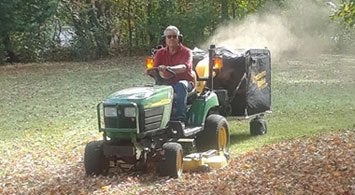
A few weeks ago we detailed the full Cyclone Rake owner experience, from the arrival in multiple boxes, assembly, installation on our test tractor, and a quick first impression use. We promised our loyal readers a detailed “how the rake performs”, and since then, thanks to a delayed fall foliage peak here in the Northeast, heavy October rains along with extremely windy days, we’ve been picking up leaves at every opportunity. This has led us to come to appreciate a number things about our Cyclone Rake, not the least of which is how quick and easy it is to get the unit from the stored position onto the tractor and then back into the shed when finished.
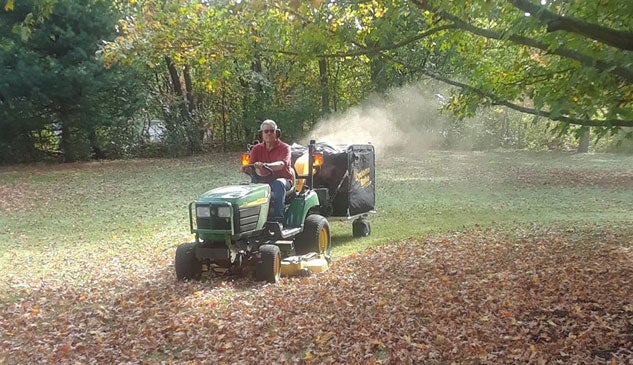
Getting the unit out of storage is just that easy. Attach the wheels to the frame, unhook the unit from its upright stored position against the wall and lower to floor, wheel the frame to the tractor and attach with quick pins and clips, affix the motor unit to the chassis (unit is on wheels, but is heavy, so an extra set of hands is appreciated), unfold and open the collector unit, attach the exit chute, attach the mower deck adapter to the tractor deck, attach the hose, and you’re ready to go. Everything goes together in minutes with either attached latches, quick pins and clips, or in the case of the motor, a pair of threaded clamp knobs.
Starting the Briggs & Stratton Vanguard engine continues to be a one pull exercise. Just slide the fuel shutoff lever to the “on” position, slide the choke lever to the full choke position, and pull the start cord. Running at full throttle, the Vanguard’s ~ 3-quart fuel tank lasts about 45 minutes. Restarting after refueling is again a one pull exercise. Obviously, the choice of the Vanguard engine was built around its reliability and longevity, but add easy starting, low vibration and relatively low noise to its qualities. dBA output at full throttle and measured from the operator seat is 85/86.
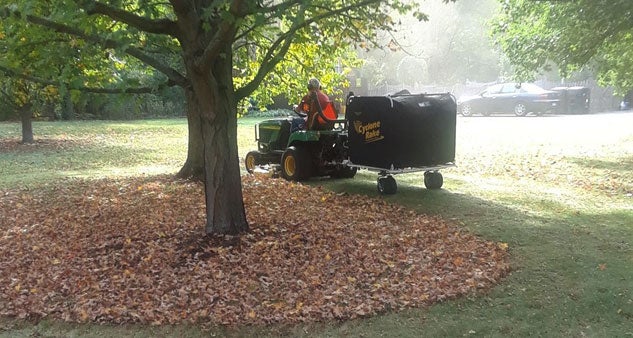
For the first leaf pickup use, we tried out a new set of Gator blades (blades with a series of tines or fingers that help chop up debris) and were surprised to see how little lift they created. The Cyclone Rake worked fine, ingesting every leaf the mower deck sent its way, but we noticed quite a bit of wet leaves left on the ground. Swapping out the Gator blades for some high-lift blades we traditionally use with our mulch setup proved to be the ticket, with the deck now not only picking up every leaf, but also acorns, pine needles, twigs, sticks, and even some unwanted bark mulch from our landscaping. Advice for every Cyclone Rake owner is to experiment with the highest lift blades available for their tractor.
While using the Cyclone Rake, we found little difference in performance when the material collected (grass, leaves etc.) was dry or wet (damp). There certainly was no clogging of the collector hose, the blower unit itself, or the exit chute that discharges into the collector/bagger. The collector unit for our test rake is rated to hold 415 gallons. With the tractor doing a good job of reducing the intake material size and the blower most likely adding to that reduction, the material going into the collector is quite dense and heavy. Adding dampness or wetness to the material only increases that weight, and can make the collector physically a bit of a challenge to dump. Contributing to the weight is the fact that the operator really has no way of knowing how full the collector unit is.
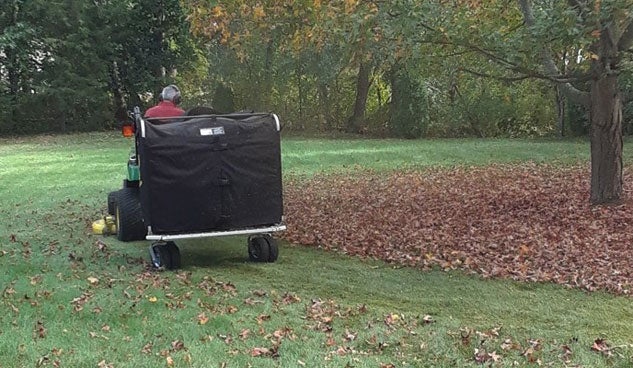
A common question asked by our testers was, “couldn’t the collector have a plastic or glass sight window?” We’ll have to believe the engineers at WPP have thought of this and most likely the reason there is no sight window is that along with the grass clippings, leaves etc. picked up, there is also quite a bit of dust which would probably discolor or prevent the operator from visually accessing what has been collected. Of course, stopping every so often and checking the collector level is the obvious and easy solution, but we found using the Cyclone Rake so enjoyable, that inevitably when we did stop, the unit was almost filled to the top.
What Spare Tractor Parts Should You Have On Hand?
One thing we did not experience was the blowing of material out the quadrilateral sides of the exit chute. We had been told that when this would happen, the collector would be full. Whether this was because we never did fill the collector right to the top, or if it had to do with the collected material being damp/wet, we don’t know.
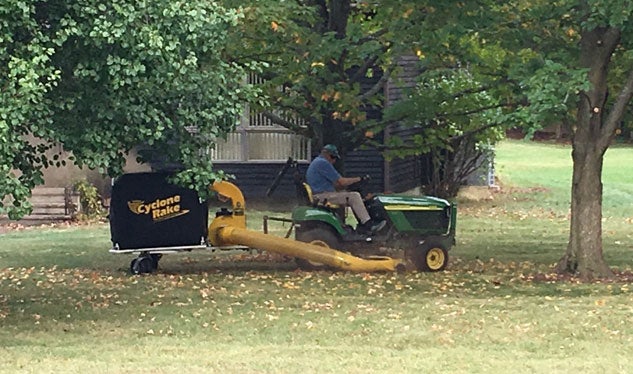
The other area we had to really pay attention to is the length of the unit, most likely exacerbated by our three-point hitch (3PH) mount. For most non-3PH installations, the Cyclone Rake from the unit rear to the tractor mounting plate, is around 6’ in length. Our setup added another 2’ to the overall length. With the Cyclone Rake frame and collector following the tractor and not swiveling as with a traditional trailed attachment and those extra two feet adding to the swing space, we’ll have to admit to clipping a few trees/shrubs etc. until we got used to the area required. We’ll also say while backing up a short distance, the dual tires don’t have a chance to turn 180 degrees. This makes exact positioning a little bit of a challenge, though as soon as the wheels rotate completely, the Cyclone Rake tracks quite well.
On a perfect fall day, sunny, 50F, light-to-moderate wind, we got the rake out and gave the lawn a manicure, frustrated only by a conspiring of Mother Nature and Father Wind as we would leave an area nearly perfectly clean only to return and find more leaves had fallen down. How dare they! But that is the beauty of how nicely the Cyclone Rake takes care of the owner’s lawn.
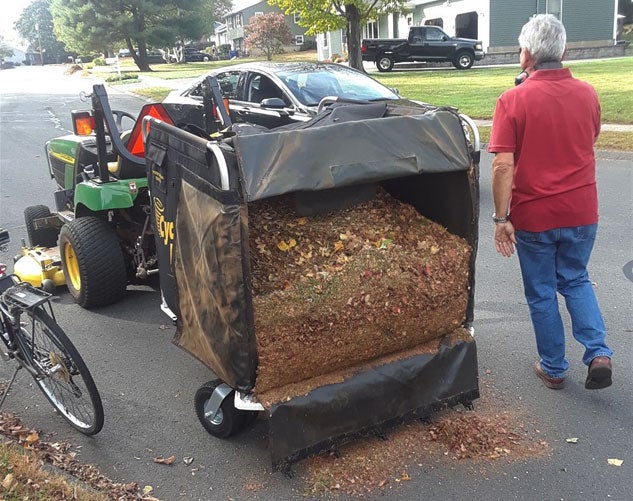
Plusses
• Easy to install and store
• Really does take up minimal space when stored
• Starts right away
• Does a really good job vacuuming up all the material the mower deck sends its way
• Does not particularly care if the material is wet or not
• Collector holds a lot of material
• High quality construction and materials used throughout
• Effortless use: Beats the heck out of any rake/tarp/help combination
Minuses
• Not inexpensive
• Add-on options can be pricey
• Operator needs to pay attention to where the rear of the unit is while turning
• Reversing takes a little getting used to
• Saying goodbye to that hand rake – especially if the vacuum hose option is purchased
Throughout the time we’ve had our Cyclone Rake, those initial favorable impressions at the thoroughness of design and engineering; quality of hardware and componentry used; and ease of storage and use, have not changed at all. In fact, we continue to be impressed. The Cyclone Rake is a quality tool that owners should expect to deliver satisfying performance for many years to come – if not a lifetime.
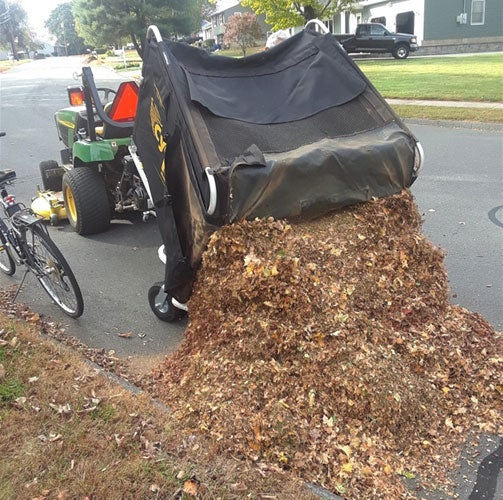 |
Prospective purchasers can visit the WPP website for more information, though if they are in the vicinity of West Haven, Conn., the factory tour is highly recommended.
 Your Privacy Choices
Your Privacy Choices